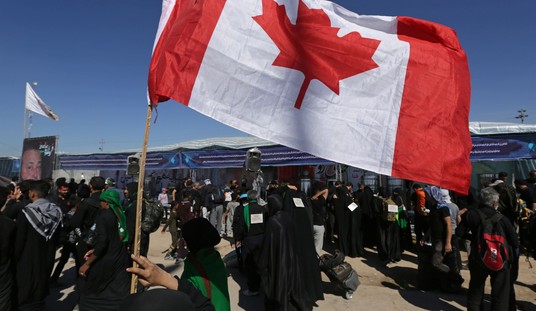The Reuters headline about her comments is stark but in keeping with the Australian approach to the pandemic: “Sydney’s unvaccinated warned of social isolation when COVID-19 lockdown ends.”
Gladys Berejiklian is the head of the government of the state of New South Wales, where Sydney is located, and therefore charged with setting COVID policy. She’s ordered a two-tier reopening after an endless lockdown based on local vaccination rates. On October 11, pubs, cafes, gyms and other public spaces will reopen — to the vaccinated only. Once the share of the population of NSW that’s fully vaccinated reaches 80 percent, which is expected around a month from now, more restrictions will be lifted — again, for the vaccinated.
Berejiklian admits in the interview that the science suggests the unvaccinated could be reincorporated into public spaces somewhat safely at that point. But just to be sure, they’re going to force the unvaxxed to stay out of those spaces for another month. Not until December 1 will restrictions finally lift for them.
More interesting than Berejiklian herself is the reaction of the two news anchors grilling her in the clip below. They’re not chiefly concerned with whether it’s fair to ice out the unvaxxed even beyond the point where it’s safe for them to return to society. What they want to know is why the unvaccinated should be allowed to resume socializing at all. Berejiklian reminds them that the government can’t bar people from participating in society forever — but she does cheerily reassure them that private businesses are free to exclude the unvaccinated forever. And given Australians’ preference for a “zero COVID” strategy, there may be a lot of businesses there willing to take her up on that. Especially if the unvaccinated share of the population is as small as 10-20 percent.
Hence the money quote: “Life for the unvaccinated will be very difficult indefinitely.”
"I want to be very clear, life for the unvaccinated will be very difficult indefinitely"
NSW premier @GladysB says citizens who don't get the COVID jab may still be refused service or entry to venues after December 1. pic.twitter.com/bgVlSGCXKv
— Sunrise (@sunriseon7) September 27, 2021
I’m earnestly curious about what sort of vaccination rate they’ll end up achieving by being such hard-asses. The U.S. still has a much larger share of the population fully vaccinated than Australia does but they’re right on the cusp of passing us when measuring by the share that’s had at least one dose. They’ve made up an enormous amount of ground in just a few months by using the promise of relief from their draconian lockdowns as a way to pressure people into getting immunized rapidly. There’s a scenario in which Aussies are 80-90 percent vaxxed within the next few months and are living life more or less normally again while America stumbles into another nightmarish winter wave of crowded hospitals, reinstated mask mandates, and social tension.
But there’s also a scenario in which they hit 80-90 percent and find themselves shocked to still be experiencing cases, hospitalizations, and deaths. Portugal is among the most vaccinated countries in the world with 85 percent having received two doses. They’re doing extremely well because of it, with just a handful of COVID deaths each day after a high of more than 300 last winter. But they’re also holding their breath, fearing that the tranquility won’t last:
One of the biggest warnings of all has come from a science institute in Lisbon, where researchers have been measuring antibody levels in several thousand people — including about 500 in Portuguese nursing homes. Shortly after those nursing home residents were vaccinated, all with the vaccine from Pfizer-BioNTech, 95 percent developed antibodies, the researchers found. But this summer, when the latest batch of blood samples arrived in coolers, the scientists performed the same tests — introducing the blood to synthetic elements of the virus — and the results were even more worrying than what they had been bracing for.
The staff at the nursing home, whose blood was also tested, still had detectable antibodies. But more than one-third of the residents had lost antibodies entirely.
Waning immunity is a problem. Breakthrough infections from a super-contagious variant like Delta are also a problem. And of course the remaining unvaccinated are a problem, since those who haven’t gained natural immunity are susceptible to severe cases if infected. Maine has one of the highest vaccination rates in the U.S. but their hospitals are under strain at the moment as Delta makes its way through the unvaxxed population. Quote: “While more than three-quarters of people are fully vaccinated in Maine’s most populous county, Cumberland, which includes Portland, the rate is 53% in more rural Somerset County. The case rate in Somerset County was recently several times higher than in Cumberland, according to the Centers for Disease Control and Prevention.”
Australia may, and probably will, experience mini-waves too as the remaining vaccine holdouts are gradually infected and it’s anyone’s guess how the country will respond. Despite its aggressive lockdown and widespread vaccination campaign, Melbourne set a new daily record for cases this morning, a problem authorities blamed on people gathering in each other’s homes to watch sports together. Nationwide, Australia is just shy of its daily record in cases on average. Once restrictions ease, it’s a cinch that there’ll be a further surge in infections despite the high vaccination rate.
What do they do then? Reinstate precautions? Suspend the unvaccinated from public spaces indefinitely for their own protection? As I say, there’s a scenario in which all of this more or less ends for the Aussies reasonably soon and reasonably well. And there’s a scenario where it doesn’t, where they’re warring over lockdown politics despite their high vaccination rate well into next year.








